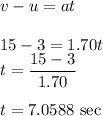
Physics, 10.07.2019 17:00 maddylosin1032
Askier is gliding along at 3.0 m/s on horizontal, frictionless snow. he suddenly starts down a 10" incline. his speed at the bottom is 15 m/s. a. what is the length of the incline? b. how long does it take him to reach the bottom?

Answers: 1


Another question on Physics

Physics, 21.06.2019 23:00
How is acceleration calculated? a. initial velocity - final velocity / timeb. initial velocity + final velocity / timec. final velocity - initial velocity / timed. final velocity / timele select the best answer from the choices provided0oood00save and exitnextmark this and return
Answers: 1

Physics, 22.06.2019 04:00
If steel is more dense that lake water, why can a boat float
Answers: 1

Physics, 22.06.2019 06:30
The coulomb's law explains which of the following? select all the force between two charged objects is inversely proportional to the charge on each object. the force between two charged objects is directly proportional to the charge on each object. the force between two charged objects is directly proportional to the distance separating them. the force between two charged objects is inversely proportional to the square of the distance separat coulomb's law is similar to newton's 2nd law. if the force between two objects is f and the charge on both objects is doubled, the new force between the would now be 2f. if the force between two objects is 2f and the distance separating them is doubled, the new force between the objects would now o the be zf.
Answers: 3

Physics, 22.06.2019 20:50
The second largest public utility in the nation is the sole provider of electricity in 32 counties of southern florida. to meet the monthly demand for electricity in these counties, which is given by the inverse demand function p = 1,200 – 4q, the utility company has set up two electric generating facilities: q1 kilowatts are produced at facility 1, and q2 kilowatts are produced at facility 2 (so q = q1 + q2). the costs of producing electricity at each facility are given by c1(q1) = 8,000 + 6q12 and c2(q2) = 6,000 + 3q22, respectively. determine the profit-maximizing amounts of electricity to produce at the two facilities, the optimal price, and the utility company’s profit
Answers: 3
You know the right answer?
Askier is gliding along at 3.0 m/s on horizontal, frictionless snow. he suddenly starts down a 10" i...
Questions

English, 05.12.2020 04:10

History, 05.12.2020 04:10

English, 05.12.2020 04:10


Mathematics, 05.12.2020 04:10

Mathematics, 05.12.2020 04:10

Mathematics, 05.12.2020 04:10

Mathematics, 05.12.2020 04:10

Mathematics, 05.12.2020 04:10

Mathematics, 05.12.2020 04:10

Mathematics, 05.12.2020 04:10

Medicine, 05.12.2020 04:10




Mathematics, 05.12.2020 04:10

History, 05.12.2020 04:10

















